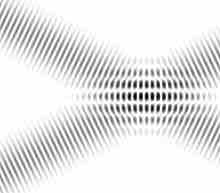Unlike solid objects, two waves can share a point in space. In physics, interference is a phenomenon in which two waves (passing through the same point) superimpose to form a resultant wave of greater or lower amplitude. Interference usually refers to the interaction of waves that are correlated or coherent with each other (i.e, "interfere" with each other), either because they come from the same source or because they have the same or nearly the same frequency.
The effects of interference can be observed with all types of waves, for example, light, radio, acoustic and surface water waves . The idea that interference is caused by superposition means that when two waves meet their two amplitudes (their maximum absolute value) combine together.

Interference
Two overlapping waves exhibit interference.
Interference can be constructive or destructive. In constructive interference, the two amplitudes of the waves add together and result in a higher displacement than would have been the case if there were only one wave. An example of constructive interference may be seen in .
Constructive Interference
Pure constructive interference of two identical waves produces one with twice the amplitude, but the same wavelength.
Destructive interference is when two waves add together and the result is a smaller displacement than would have been the case. An example of destructive interference can be seen in . When the waves have opposite amplitudes at the point they meet they can destructively interfere, resulting in no amplitude at that point. For example, this is how noise cancelling headphones work. By playing a sound with the opposite amplitude as the incoming sound, the two sound waves destructively interfere and this cancel each other out.